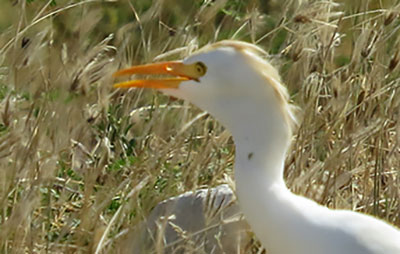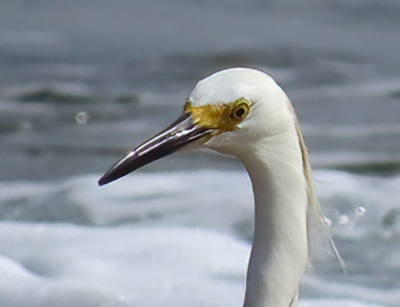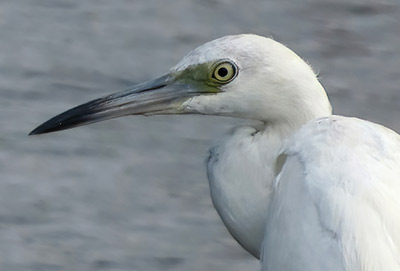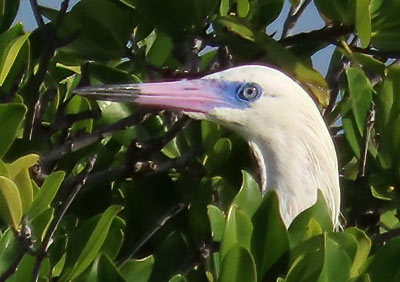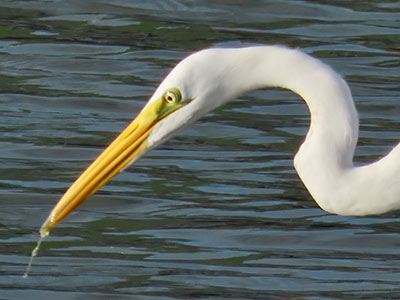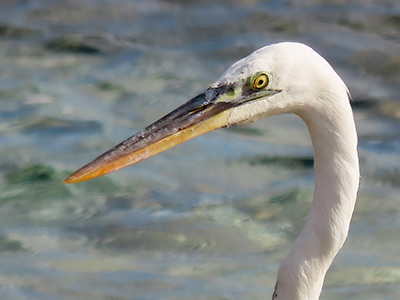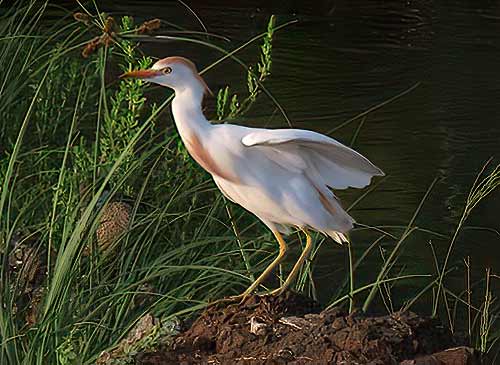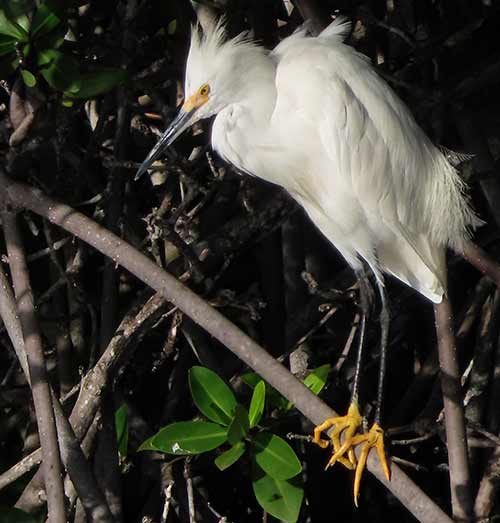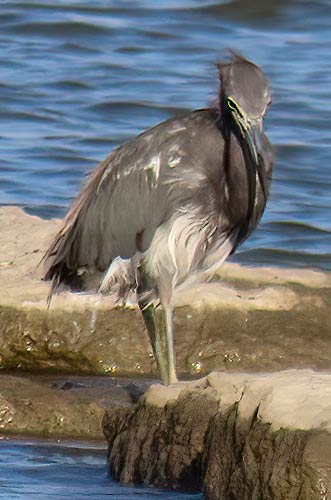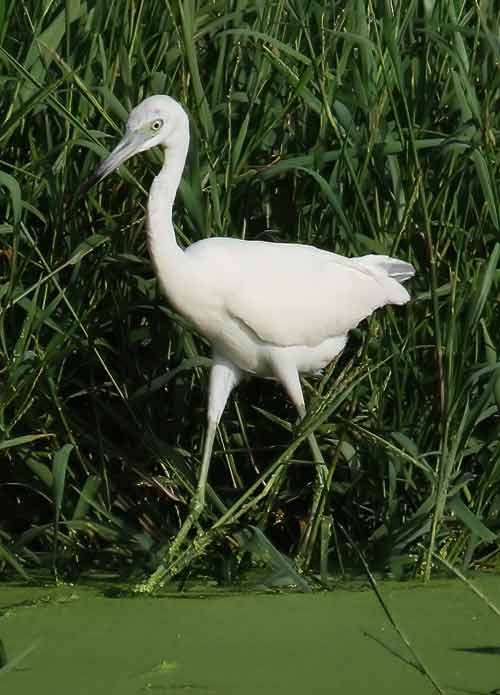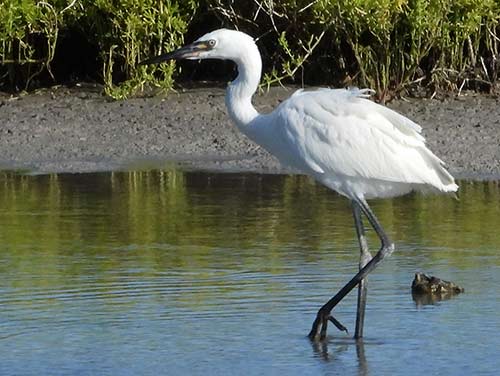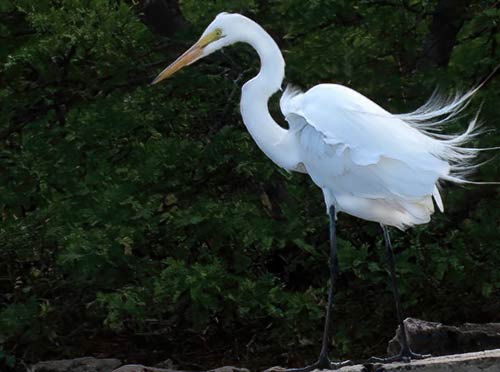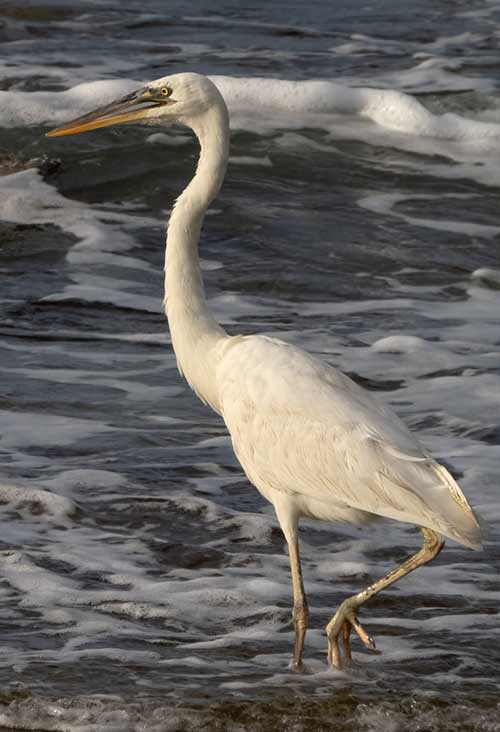How to identify Bonaire’s big white birds.
When you see a large white egret or heron on Bonaire, it could be any of six species. Here’s a primer on how to tell them apart.
Posted April 7th, 2022
What Are Those Big White Birds You See Around Bonaire?
Bonaire has no lack of “big white birds,” but sometimes it can be difficult to tell them apart. This guide will give you a few hints and tips as to what to look for when attempting to identify one of the island’s big, white birds!
What should I look for first?
Let’s start off with some questions that you should ask yourself immediately when spotting one of Bonaire’s big white birds:
How big is it?
If you’ve been birding for a while, you probably can give the bird “an eyeball” and immediately ascertain how large it is, although, with some herons, looks can be deceiving when they are hunched over.
However, newbie birders might find this manner of establishing size more difficult. In this case, find something in your field of vision that you can approximately measure; a rock, a tree or bush, even another bird you can identify. Once you know the size of that object you can judge the size of a bird in comparison.
What shape is it?
What general shape does your big white bird have? Is it tall and slim, or short and more rotund? How about the length of the legs? Each of the answers to these questions can help with the identification of your big white bird.
What color and type of bill does it have?
Bills are adapted to the type of food the birds prefer. Generally, the big white birds you will encounter on Bonaire are egrets or herons. Both have long, dagger-like bills, but mostly the herons will have much thicker bills than the egrets you will encounter.
How does it behave?
Is your bird motionlessly stalking its prey? Is it dancing around while it forages? A bird’s behavior can be used to help identify the species of the big white bird.
What color are the bird’s legs?
The leg color (and, in some cases, the foot color) is always very important. In some cases, the leg color is all you’ll need to tell you exactly what species it is.
Next, let’s take a look at Bonaire’s big white birds and apply the answers to those questions.
Cattle Egret
This smallest of Bonaire’s big white birds gives a compact shape because it has relatively short legs, and a short neck, both of which are beneficial since it forages on land. The bill is also rather short when compared with other herons or egrets; it’s just a bit longer than the length of the head.
It’s interesting to note that the Cattle Egret is the only species in its genus in the world, and the only North American egret or heron in which the color of the plumage changes seasonally.
In normal adult plumage, it sports all-white plumage and a yellow bill and its legs and feet are dark. However, breeding birds have orange feathers on their crown, their back, and the front of their neck, and the bill can also turn more orange and the legs more yellow when the bird is in breeding plumage, as illustrated here.
Cattle Egret (Bubulcus ibis)
Size: 20 inches or 51 centimeters tall
General shape: Small and compact
Color and type of bill: Short yellow (can turn orangish in breeding plumage)
Behavior: Forages on the ground in grassy fields
Color of legs (and/or feet): Normally dark (can turn yellow in breeding plumage)
Snowy Egret
This resident is common in or around water. It has white, fine plumage with a black bill, black legs, and bright yellow feet. In water, it usually moves around often and quickly, using its yellow feet to stir up prey, and it is often called “the lady with the golden slippers.”
The impression of the Snowy Egret is of a slender, medium-sized bird. It is equally at home in fresh, brackish, or saltwater, so it can be observed in many locations around Bonaire and can be found in the company of Great Egrets and other herons as well.
Observers can use the behavior of Snowy Egrets for help in identification. They often will be seen to be in animated pursuits after their prey, but the bird can also hold still in crouching vigils with its neck coiled and ready to strike, stabbing its prey with its straight bill when a fish dares to get close.
Snowy Egrets nearly always show a black or blackish bill with yellow lores. However, here on Bonaire, we can observe Snowy Egrets in breeding plumage, when the lores and their feet turn a bright red and they develop wispy plumes of snow-white feathers along their body and back.
Snowy Egret (Egretta thula)
Size: 24 inches or 71 centimeters tall
General shape: Slender and medium-sized
Color and type of bill: Black bill with yellow lores (the lores can turn reddish in breeding plumage)
Behavior: Forages in freshwater, brackish water, or saltwater
Color of legs (and/or feet): Adults have black legs with strikingly yellow feet (the feet turn red in breeding plumage)
Little Blue Heron, Immature
One would think that a bird called the Little Blue Heron would be, well, blue. And the adult Little Blue Heron is indeed a gray-blue with a reddish head and neck. However, when young, first-year birds have stark white plumage. They can usually be identified from other big white birds by their greenish-colored legs and their two-toned blue-and-black bill. Here on Bonaire, we can observe the Little Blue Heron in all three plumages: the first-year birds in their white plumage, molting birds, called “calicos,” that are replacing their white feathers with adult-colored blue feathers, and full adult Little Blue Herons with the gray-blue body and reddish heads and necks.
A “calico”–a Little Blue Heron molting from its first-year white plumage into its adult plumage.
Little Blue Heron (immature) (Egretta caerulea)
Size: 24 inches or 71 centimeters tall
General shape: Similar in size to the Snowy Egret, but heavier in the body with thicker necks
Color and type of bill: Gray-blue bill, with a darker tip; the bill droops slightly at the end
Behavior: Their general body stance and movements are more sluggish than of the similarly sized Snowy Egret
Color of legs (and/or feet): Green
It is the white juveniles that are most confusing for birders. Similar in size to Snowy Egrets, juvenile Little Blues are slightly heavier, with thicker necks and a heavier, droopier, usually two-toned bill that is paler at the base. The lores are grayish or yellowish (never bright yellow like the Snowy Egret’s) and blend into the gray-based bill, which becomes darker toward the tip. Note their structure and generally sluggish movements. When they forage, the bill is usually pointed down (not horizontally). Just in case the bird takes flight before you get a good look, be sure to watch for the dark gray wingtips in flight–no other big white bird will display these and you’ll still be able to identify your bird!
Reddish Egret (White Morph)
The Reddish Egret can be observed in two colorations: the “dark morph” presents a gray-blue body with a reddish head and neck, while the “white morph” presents an entirely white body.
Both adult colorations can be easily identified by the long, two-toned bill, which will be pink at the base and black at the tip. Note that juveniles and immature Reddish Egrets will display other colors in the bills.
The adult white morph of the Reddish Egret can be also identified by the shaggy, white “mane” of plumage on the head and neck, which will differentiate it from the slightly smaller-sized Snowy Egret or immature Little Blue Heron.
Also, be sure to check out the color of the legs. Adult Reddish Egrets of both colorations display dusky blue legs and feet.
The behavior of the Reddish Egret when foraging is quite distinctive and is an easy identifier of the species. The Reddish Egret will often dance around, moving quickly, hopping back and forth, and running in spurts or spinning around, as it forages in the water for fish and small invertebrates. Often, the Reddish Egret will spread its wings out, to create shade and attract its prey.
Reddish Egret (white morph) (Egretta rufescens)
Size: 30 inches or 76 centimeters tall
General shape: medium to large size, slim, but with a shaggy “mane” on the head and neck (adults only)
Color and type of bill: An elongated, bi-color bill with pink at the base and a dark tip
Behavior: Very active when foraging, with running, dancing, and spinning; it may spread its wings to create shade to attract its prey
Color of legs (and/or feet): Dusky blue in adults
Great Egret
The Great Egret is second in size only to the Great White Heron (pictured below).
The Great Egret is consistent in its appearance across all ages. It is easily identified by the combination of its large size, black legs, and stout orange-yellow bill, but some can display a black-tipped bill. The Great Egret moves with a thoughtful deliberateness, frequently foraging with its bill held horizontal, or even tilted up to the sky, until it plunges its head into the water to spear a fish.
Great Egrets can be found in either saltwater or freshwater or in attendance with other herons or egrets, especially the Snowy Egret. Occasionally they can be found to prefer drier pastoral habitats and on Bonaire, can even be observed foraging along the grassy side of a road.
As adults, Great Egrets lack head plumes. Instead, during their breeding season, the lores become rich green, and the long back (scapular) plumes become evident and can be a buffy or brownish color. Nonbreeding Great Egrets are similar, but the lores are a duskier color of yellow and the legs are less richly black.
Great Egret (Ardea alba)
Size: 36 inches or 91.5 centimeters tall
General shape: Large size, second in height only to the Great White Heron
Color and type of bill: Long and stout orange-yellow bill
Behavior: Moves with a thoughtful deliberateness, with its bill held horizontal or even upward
Color of legs (and/or feet): Black legs and feet
The Great White Heron (White Morph of the Great Blue Heron)
Since my early birding days, I affectionately dubbed the white morph of the Great Blue Heron as “Big Bird.” However, the name from the famed Sesame Street children’s television show does not do justice to this statuesque, sleek, and elegantly plumaged heron with an extremely long neck and legs.
In North American taxonomy, when in its white morph, this bird is considered a subspecies of the Great Blue Heron and is commonly referred to as the Great White Heron. Other taxonomists argue it is a separate species. No matter how the bird is classified, it is still a stunning bird to encounter, especially since it is considered very rare to be observed so far south of Cuba, which is normally its southern-most range. To find it on Bonaire is truly a treat!
This heron uses its long and thick, two-toned dagger-like bill to stab at fish, frogs, or large insects, all the while wading gracefully along the intertidal zone of the shoreline. Its legs are a dull yellow and the lores by the eyes can be grayish-blue.
Great Blue Heron (white morph) (Ardea herodias occidentalis)
Often referred to as the Great White Heron
Size: 31 to 41 inches or 79 to 104 centimeters tall
General shape: Tall, sleek, and statuesque
Color and type of bill: Very thick dagger-like bill, two tones on the upper and lower
Behavior: Will elegantly wander along the shoreline or in the shallow water, and then will quickly strike when it sees its prey.
Color of legs (and/or feet): Dull yellow
So now you’ll be equipped with the knowledge to identify every big white bird you encounter on Bonaire. I hope you enjoy your birding adventures on the island!
About the author:
 Susan has been living on Bonaire for over 30 years. She is a certified bird guide, as well as a topside and underwater photographer. She is a 2016 graduate of the Caribbean Birding Trail Interpretive Guide Course conducted by BirdsCaribbean.
Susan has been living on Bonaire for over 30 years. She is a certified bird guide, as well as a topside and underwater photographer. She is a 2016 graduate of the Caribbean Birding Trail Interpretive Guide Course conducted by BirdsCaribbean.
Get in touch with Susan
Contact Susan via email, Facebook Messenger, call Susan or use the online form below.
If you have any questions about your Bonaire birding tour, feel free to contact Susan for answers. She is always willing to go into more detail about routes or the best times for a tour based on your personal preferences. Tours can be tailored to your interests, whether that be birds, photography, or both!
It is also a good idea to do some homework on the birds of Bonaire before you come. Knowing a little about the birds you might encounter on your tour will make your experience even more enjoyable!
Be sure to check out these resources for birding on Bonaire. Also, reading the Bird Blog will introduce you to the birds that might be observed on Bonaire.
Get In Touch
Get in touch with Susan to check availability for the dates you are visiting Bonaire.
Consent: By using this form you agree with the storage and handling of your data by this website.

